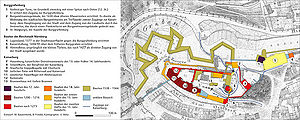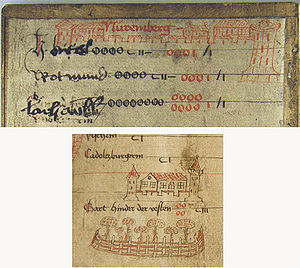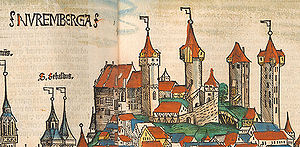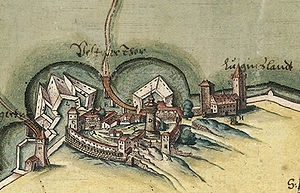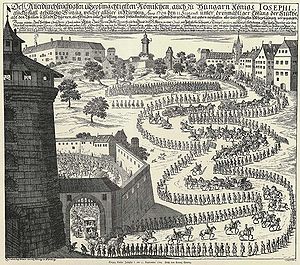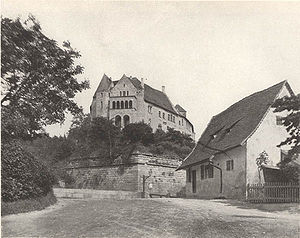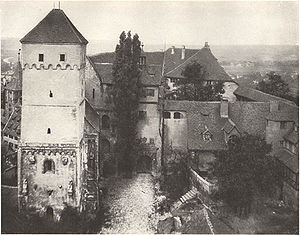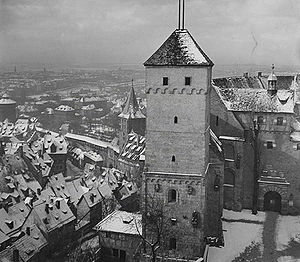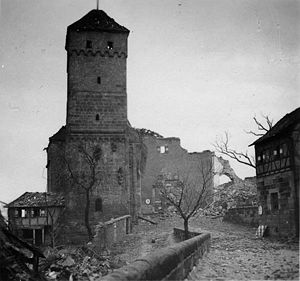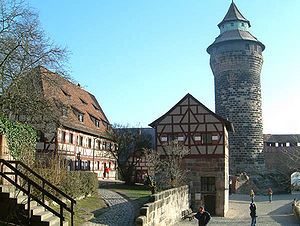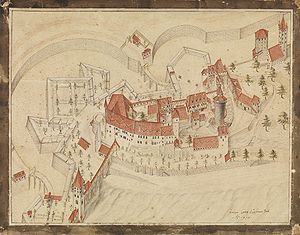
The castle, which can be traced back archaeologically to the 10th century, was first mentioned in a document in 1050. The castle consists of the Imperial Castle, the Burgrave's Castle, which was largely destroyed in 1420, and the imperial city's buildings. As the Imperial Castle of the Salian and Hohenstaufen rulers, the Nuremberg Imperial Castle was the venue for Hoftag assemblies and other important events in imperial politics until the late Middle Ages. In 1313, the Imperial Castle with its buildings from the Hohenstaufen period (Palas, double chapel) passed into the care of the imperial city. The Burgrave's Castle of the Hohenzollern Burgraves of Nuremberg, located to the east, was destroyed in 1420 and sold to the imperial city in 1427. As owner of the entire castle, the imperial city erected further buildings (e.g. imperial stables) and incorporated the castle into the modernised city fortifications (bastions) in the 16th century. The castle has been the object of projections for a wide variety of medieval ideas since the 19th century. In this context, it was rebuilt in the historicist style by August von Voit (1801-1870) and by Rudolf Esterer (1879-1965) in 1934/35. The castle, largely destroyed in 1945, was restored by 1981.
Topographical position
Nuremberg Castle is still the landmark of the city of Nuremberg today. It is situated on a sandstone rock, majestically sprawling about 50 m above the city. It is often referred to as the "Imperial Castle", although the Imperial Castle is just one part of the castle's complex structure. The castle actually consists of several parts: in front of it are the late medieval town buildings, followed by the Burgrave's Castle, which is only partially preserved. Through the Freiung, an originally ecclesiastical area, you first reach the outer castle and then the main castle of the Imperial Castle complex.
-
Ground plan and architectural history of Nuremberg Castle. Map by Birgit Friedel and Walter Bauernfeind. (from: Der Nürnberg-Atlas. Vielfalt und Wandel der Stadt im Kartenbild, Nuremberg 2007)
-
Earliest representation of Nuremberg Castle in a wax tablet interest ledger from around 1425. (Staatsarchiv Nürnberg (Nuremberg State Archives), Nbg_Salbuecher_15c_fol 1b and 2b)
-
Representation of Nuremberg Castle in the city view of 1493. Fig. from: Hartmann Schedel, Liber Chronicarum, Nuremberg 1493, fol.99v-100r. (bavarikon) (Bayerische Staatsbibliothek (Bavarian State Library), 2 Inc.c.a. 2919)
-
Nuremberg Castle in the Pfinzing Atlas of 1594, fol. 13 (Staatsarchiv Nürnberg, B 444)
-
Procession of the later Emperor Joseph I (ruled 1705-1711) up to Nuremberg Castle on 11 September 1704. The engraving shows the individual parts of the procession in baroque style. Copperplate engraving by Johann Lorenz Hoening (1674-1713). Fig. from: Hugo Barbeck, Alt-Nürnberg. Kulturgeschichtliche Bilder aus Nürnbergs Vergangenheit, vol. 13: Kaisertage und Bürgerlust, Nürnberg 1901, sheet 3. (Bayerische Staatsbibliothek, 2 Bavar. 32 v-11/14)
The early days of the castle
A series of excavations over the last few decades has produced a multitude of new results on the history of the castle’s construction. They revealed that, since the 10th century at the latest, there has been a fortification on the castle hill the size of today's complex. Archaeological evidence of this early castle includes pit workings facing east and west and a palisade. Since there is no documentary evidence, the builders can only be inferred. Arguably, only the most powerful dynasty in the region in the 10th century, the Margraves of Schweinfurt, who had held the margraviate in Bavaria's Nordgau since 939 and owned a number of other castles, might be considered for the construction of such a large complex. Urban archaeological research in recent years has shown that a settlement had also already extended below the castle in the 10th century.
After the destruction of the margrave's castle, a Palas building and two smaller buildings were erected in the 11th century facing a completely new direction. These new buildings belonged to a royal complex, in which Heinrich III‘s (ruled 1039-1059) Hoftag assembly on 16 July 1050 probably took place, where Nuremberg is mentioned for the first time.
The castle was subsequently the scene of several disputes. The Palas was damaged during the siege by Lothar von Süpplinburg (ruled 1125-1137) in 1130, but was immediately rebuilt at the same time as a large residential tower located directly to the north of it over an irregular ground plan. The ensemble also included a castle chapel, a predecessor to today’s double chapel. The main castle was therefore given a completely new look during the reign of Konrad III (ruled 1138-1152). Konrad's son Heinrich (died 1150) spent several months here in 1148, while his father took part in the Second Crusade.
Massive construction works can also be traced in the Burgrave's Castle during this time. The oldest buildings in the southern part of the Burgrave's Castle are several stone buildings, including a chapel and a residential tower. They were probably built by the first burgraves, the Lords of Raabs. The Pentagonal Tower, which is still standing today, can also be dated to around 1150. Like the other fortified buildings, it was probably built by order of "the empire" and thus the king. These newly constructed buildings suggest that a royal official already lived in this outer castle of the royal palace before 1138, possibly since 1105.
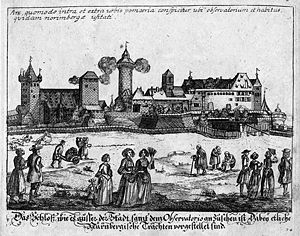
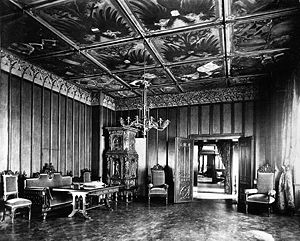
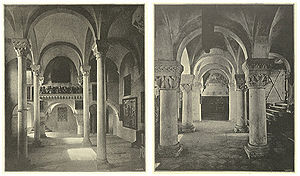
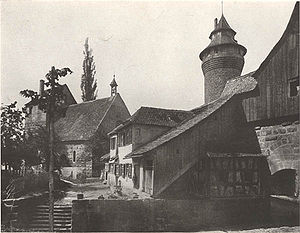
The castle as a seat of representative significance for the Hohenstaufen rulers
While Konrad's reign came with fundamental renovations, under Friedrich I Barbarossa (ruled 1152-1190) the castle was mainly used for major representative events, such as receptions of legations and Hoftag assemblies. This led to the opinion – which is still omnipresent today - that Barbarossa had extended the castle in this form. However, no constructions of new buildings are documented during his reign. Obviously, he made full use of the buildings erected under his predecessor Konrad.
Fundamental reconstructions were only carried out again by Friedrich's successors. Friedrich's son Heinrich VI (ruled 1190-1197) is presumed to have been the initiator of these alterations. Several buildings - that still exist today - were constructed: a two-part Palas consisting of two halls on top of each other and an adjoining residential wing as well as a double chapel next to the gate, which with its lower chapel, upper chapel and ruler's gallery is actually triple-tiered. In addition, a round chapel was set up in the basement of the Palas as a palace chapel, which was possibly intended to house the Imperial Regalia and which was already demolished at the end of the 13th century. The end point of the construction work for the double chapel is marked by its handover to the Teutonic Order by Friedrich II (ruled 1212-1250) in 1216, which probably held it until 1419 and then handed it over to the city of Nuremberg. The final works on the chapel were not yet completed in 1216.
The castle developed into a popular residence for Friedrich II's sons. Heinrich (VII) (ruled 1228-1235) in particular stayed in Nuremberg every year. The Palas was also usable by 1225 at the latest. That year, a double wedding was held between 14-year-old Heinrich and Margarethe of Austria (died 1266) and – at the same time – between her brother and the daughter of the Landgrave of Thuringia. During the celebrations, the staircase from the lower to the upper hall collapsed and, according to the chronicler, buried about 60 wedding guests.
Rudolf of Habsburg and the House of Hohenzollern
The interregnum ended with the coronation of Rudolf von Habsburg (ruled 1273-1291) on 25 October 1273. He approved a plethora of rights for the Nuremberg Burgrave Friedrich III von Zollern (died 1297) the day after the election, as he was one of his most important allies in getting elected.
Nuremberg was highly in Rudolf's favour in other respects too. For example, he spent a total of 269 days in Nuremberg during his 18 years of government. The extensive new constructions around the castle instigated by Rudolf suggest that the king wanted to affiliate himself with the centuries-old tradition of the Salian and Hohenstaufen dynasties. On the ground floor in the Palas, a continuous hall with large windows was created, similar to the ones on the upper floors. The lavish use of the "modern" building material brick, which was used as a shaped brick not only for the windows but also for the extension of the chapel tower and the raising of the palace gables, is striking.
The castle in the Late Middle Ages
Heinrich VII (ruled 1308-1313) transferred the castle to the city's care in 1313. The castle was now part of the up-and-coming city and lost importance as the cities attractiveness increased. For example, Ludwig der Bayer (ruled 1314-1347) preferred the noble accommodation in the houses of the patricians Ebner, Haller and Groß to staying in the castle during his 74 visits. Karl IV (ruled 1346-1378) also preferred to be accommodated by patricians such as Ulman Stromer (1329-1407). The castle was rather used for symbolic acts, for example as the birthplace of the heir to the throne, Wenceslas (ruled 1376-1400, died 1419). To celebrate his baptism, Karl had the Imperial Regalia brought from Karlstein to Nuremberg and shown in the double chapel. Friedrich III (ruled 1440-1493), who stayed in Nuremberg several times for several months and resided in the castle, also appreciated the security of the castle and the city. This is shown by the fact that in 1485 he handed over the House of Habsburg's treasure to the Nuremberg citizens, in several chests sealed with a signet, for safekeeping in the lower chapel. In 1487, he had relics placed in the altar of the upper chapel, which was its first documented consecration. Friedrich's son Maximilian I (ruled 1486-1519) was the last ruler to hold his first Reichstag (Imperial Diet) in Nuremberg, for which he lodged at the castle for almost half a year.
The Burgraves of Nuremberg and the Burgrave's Castle
The signature of Fridricus "prefectus de Nuremberg" (died around 1200) in 1192 documents, for the first time, a Count von Zollern als Burgrave of Nuremberg. The rise of the family was accelerated by their shares in the inheritance of the Counts of Abenberg, who died out around 1200, and the House of Andechs-Merania in 1248. Besides Nuremberg/Cadolzburg, the House of Hohenzollern now had a second focal point around Bayreuth/Kulmbach. The extensive powers granted by the enfeoffment document of 1273 are to be interpreted as proof of the favour of Rudolf von Habsburg, who rewarded the burgrave with this for his active assistance in the election of Rudolf as king.
The appreciation of the burgraves became apparent in a representative extension of the Burgrave's Castle. An at least three-storey residential building was erected between the main gate and the Pentagonal Tower, which was probably the House of Hohenzollern's gatekeeper. After the death of Konrad II von Raab (died c. 1191), the southern part of the Burgrave's Castle went to the St. Egidien monastery in Nuremberg. Therefore, the Hohenzollern dynasty could only use the northern part of the Burgrave's Castle. This puts a remark by the Nuremberg town chronicler Sigmund Meisterlin (died 1491) into context in which he described the Burgrave's Castle as a "parvum fortalitium", i.e. a small fortification. The Pentagonal Tower from around 1150 and the Walpurgis Chapel, probably built after 1273, still exist today on the southern part of the castle grounds, the area of the St. Egidien monastery. A stone residential tower was replaced around 1430 by the castle bailiff building that still exists today.
In the 13th and 14th centuries, the relationship between the burgraves and the city of Nuremberg deteriorated. In 1377, the city council therefore had the Luginsland built in front of the Burgrave's Castle. However, the rise of the Hohenzollern dynasty could not be stopped and was due not least to their close relationship with royalty. Prominent points along their rise are their elevation to the rank of princely earl in 1363 by Karl IV and the transfer of the Margrave of Brandenburg by King Sigismund (ruled 1410-1437) in 1411/1415. The end of the House of Hohenzollern in Nuremberg came just a short while later. In the inheritance war between Duke Ludwig dem Bärtigen of Bavaria-Ingolstadt (ruled 1413-1443) and the Nuremberg Burgrave Friedrich VI (ruled 1397-1440), the Wittelsbach keeper in Lauf (Nürnberger Land district) burned down the Burgrave's Castle in October 1420. Thereupon Friedrich, by then Margrave of Brandenburg, sold the Burgrave's Castle for about 120,000 gulden to the Imperial City of Nuremberg in 1427.
The imperial city was now in possession of the entire castle complex. On the site of the western residential tower, it built the castle bailiff building for the city bailiff by 1430. The adjacent Vestner Gate now became the main gate to the castle since the front gate had been destroyed. In 1495 the city filled the square between the Luginsland and the Pentagon Tower with the Imperial Stables, a combination of stables and a granary.
From the early modern period to the present day
As part of the city walls, the castle was an important bulwark during the wars of the Early modern period, too. This was reflected in the construction of the bastions in 1538-1545, which for a short time gave the town a leading position in southern German fortress construction. The Imperial Castle's outer bailey was extended in the 1560s: the Sinwell Tower was given a cornice and the Deep Well a well building. Nevertheless, the rulers of the 16th and 17th centuries rarely stayed in Nuremberg anymore. After Matthias (ruled 1612-1619) in 1612 and Leopold I (ruled 1658-1705) in 1658, Joseph I (ruled 1705-1711) too stayed in Nuremberg for only a few days in 1704. The Palas was therefore subsequently used as an exhibition space for works of art from the city.
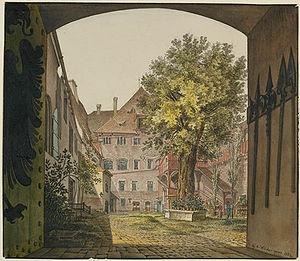
When the imperial city of Nuremberg was mediatised in 1806, the castle became the property of the Kingdom of Bavaria. According to the 1856 treaty between the Kingdom of Bavaria and the City of Nuremberg, which is still valid today, the entire castle has belonged to the Kingdom of Bavaria or the Free State as its legal successor ever since. After the Second World War, the city of Nuremberg was given the Luginsland, the Imperial Stables and the Pentagonal Tower via hereditary building rights. The city is also responsible for the building maintenance there.
In 1833, a plan was drawn up to extend the castle as a residence for King Ludwig I of Bavaria (ruled 1825-1848). Based on the designs by Carl Alexander von Heideloff (1789-1865), the extension of the first floor, now accessible from the courtyard by a staircase, was completed. Since the interior decoration did not suit the king's taste, further extensions were stopped after a short construction period. King Maximilian II (ruled 1848-1864) decided to continue the restoration in 1851. He intended to restore it on a large scale and commissioned the architect August von Voit (1801-1870) to design and build it. The works, which resulted in interior fittings and the addition of a balcony to the western Palas wall, were abandoned after the death of Maximilian in 1864.
These reconstructions in the Historicist style of the 19th century were disqualified in 1934/35 as "weakly, academic style forms" and dismantled by Rudolf Esterer (1879-1965). (1879-1965). The castle now reflected the rather rustic medieval image of the "Third Reich". The Imperial Stables were converted into a youth hostel. The castle, up to 70-80% of which was destroyed in the devastating bombing raid on 2 January 1945, was restored by 1981 and is now one of Nuremberg's main tourist attractions.
-
The Imperial Castle from the west with the balcony built by August von Voit. Photograph by Ferdinand Schmidt from the end of the 19th century. (from: Bier, Das Alte Nürnberg, plate 4)
-
The Imperial Castle with Heathens' Tower and double chapel. The photograph by Ferdinand Schmidt taken at the end of the 19th century shows that the buildings were mostly plastered. (from: Bier, Das Alte Nürnberg, plate 5)
-
Heathens' Tower and double chapel after the renovation by Rudolf Esterer. The plaster of most of the buildings was removed because the Third Reich's image of the Middle Ages required stone-faced and unplastered walls. (Bayerisches Landesamt für Denkmalpflege (Bavarian State Office for the Preservation of Monuments)
-
Heathens' Tower and double chapel after their destruction by bombs on 2 January 1945. (Bayerische Staatsbibliothek, Hoffmann photo archive)
-
Imperial Castle with Sinnwell Tower around 2010. (Birgit Friedel)
References
- Erich Bachmann (Bearb.), Kaiserburg Nürnberg. Amtlicher Führer, München 1978.
- Der Kaiser in Nürnberg. Archivalienausstellung des Staatsarchivs Nürnberg in Verbindung mit der Bayerischen Verwaltung der staatlichen Schlösser, Gärten und Seen auf der Kaiserburg zu Nürnberg, Nürnberg 1962.
- Günter P. Fehring, Zur älteren Geschichte von Burg und Pfalz zu Nürnberg auf Grund neuer Grabungsergebnisse der Archäologie des Mittelalters, in: Burgen und Schlösser 13 (1972), 10-17.
- Birgit Friedel, Der Wiederaufbau der Nürnberger Burg, in: Wiederaufbau in Nürnberg. Ausstellungskatalog des Stadtarchivs Nürnberg und der Museen der Stadt Nürnberg, Nürnberg 2009, 214-221.
- Birgit Friedel, Die Nürnberger Burg. Geschichte, Baugeschichte und Archäologie (Schriften des Deutschen Burgenmuseums 1), Petersberg 2007.
- Georg Ulrich Großmann/Birgit Friedel, Die Kaiserburg zu Nürnberg. Literaturbericht und Forschungsstand, in: Georg Ulrich Großmann (Bearb.), Burgenbau im 13. Jahrhundert (Forschungen zu Burgen und Schlössern 7), München u. a. 2002, 83-98.
- Thomas Liebert, Die Nürnberger Kaiserburg. Geschichte in Stein gemeißelt. Stadt Nürnberg, Mittelfranken, in: Das Archäologische Jahr in Bayern (2004), 159-161.
- Rudolf Schieffer, Nürnberg: die Kaiserburg als Herrschaftszentrum der Salier und Staufer, in: Alois Schmid/Katharina Weigand (Hg.), Schauplätze der Geschichte in Bayern, München 2003, 90-103.
- Markus Twellenkamp, Die Burggrafen von Nürnberg und das deutsche Königtum (1273-1417), Nürnberg 1994.
Further Research
External Links
Related Articles
- Hohenzollern, Fränkische
- Nuremberg, Imperial City: Political and Social Development
- Nuremberg, Imperial City: Territory
Kaiserburg, Nürnberger Burg
Cite
Birgit Friedel, Nuremberg Castle, published 04 October 2010, English version published 06 March 2024; in: Historisches Lexikon Bayerns, URL: <https://www.historisches-lexikon-bayerns.de/Lexikon/EN:Nuremberg_Castle> (20.12.2025)

